They may look similar, but the praying mantis and stick bugs are two different insects belonging to the order Mantodea and Phasmatodea respectively.
To understand the different complexities of these insects you will need to look at their taxonomy, appearance, and diet.
Stick bugs are also known as walking insects or bug sticks, and they literally resemble small dead twigs. On the other hand, praying mantises are also long, but they do not look like twigs, although they can camouflage adequately in their habitat.
In order to find out the subtle differences between stick bugs and praying mantis, read on.
How Do Praying Mantis And Stick Bugs Compare In Appearence?
Stick Bugs
With a unique appearance resembling a caricature made from twigs, stick insects are long and tend to move slowly. Their bodies have a sheen that makes them look glossy and their antennae are long. Stick bugs are very slender which helps them easily pass for twigs.
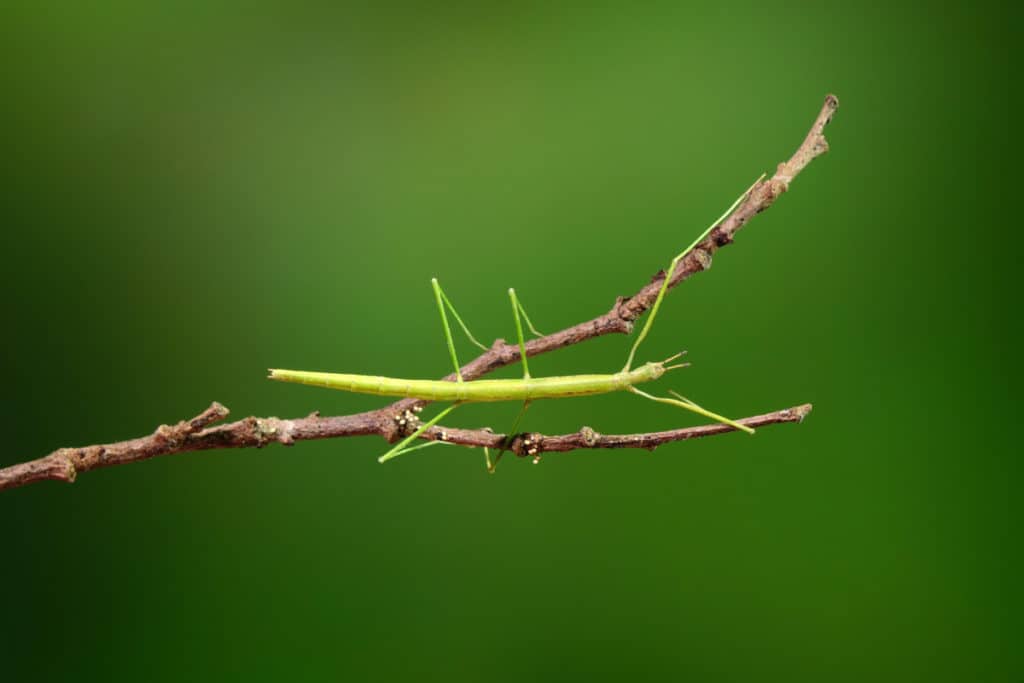
These bugs may vary in size with some being as small as half an inch to 13 inches in some species. The smallest stick bug is the Timema Cristinae, while the largest size measuring 13 inches is the Phobaeticus Kirbyi, found in Borneo. In fact, the Phobaeticus is one of the largest insects on earth when it rises to its full length of 21 inches.
The typical color of stick insects is black, brown, or green. These insects are capable of limb autotomy meaning they can shed limbs.
Praying Mantis
The praying mantis has long legs and looks gangly with species like the Devil’s Flower Mantis and the Ghost Mantis resembling dead leaves. Other species look nothing like sticks or branches like the Spiny Flower Mantis and the Orchid Mantis that are colorful, camouflaging themselves in flowers.
Their front legs are bent and appear to come together in a prayer-like pose earning the name praying mantis. These insects have a triangular-shaped head with two large compound eyes on both sides and three simple eyes in between.
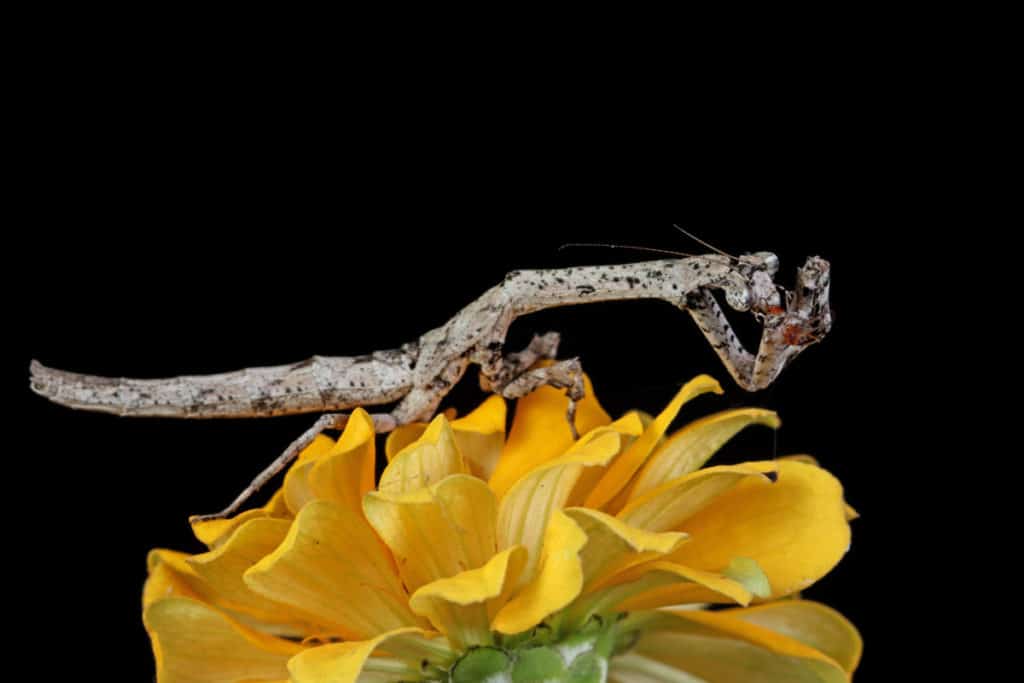
The praying mantis can comfortably turn its head 180 degrees because the head sits on an elongated thorax. Their size varies depending on the species. For example, the Chinese Praying Mantis can grow up to 5 inches and the smaller Carolina mantis will only get to 2 inches.
A praying mantis has an elongated abdominal area that is covered with wings. They are not capable of limb autotomy.
Where Do You Find Stick Bugs And Praying Mantis?
Stick Bugs
Stick bugs tend to favor the tropic and subtropical climates but some species can survive in temperate climatic conditions. They seek out grasslands and forest cover because these are habitats that offer excellent camouflage for them.
They are nocturnal creatures, as they come out to feed at night. During the day, you are likely to come across them hidden under the leaves of plants during the day as they remain motionless to fool and avoid predators.
Stick bugs generally thrive in temperatures of 68 degrees Fahrenheit which is the normal room temperature. Anything less than 59 degrees Fahrenheit is harmful and could lead to the death of the insect.
Praying Mantis
The Praying mantis also favors warmer temperatures but they are more adventurous compared to the stick insects because some species can venture into hotter regions like deserts depending on the species. They also can be found in meadowlands since these are insects that go where their prey is present.
Praying mantis thrives in outdoor temperatures of 60 degrees Fahrenheit which is around the range of normal room temperature. The species can live in drier areas when they find a habitat that allows them to shelter from the elements. But they can comfortably exist in temperatures of as much as 90 degrees Fahrenheit.
In this respect both the praying mantis and stick insects are similar in regard to the temperatures they prefer.
What Time Of Year Are They Active?
Stick Bugs
In warmer climates, tropical and subtropical, you will see stick bugs all year round. But in temperate climates, the females lay eggs in autumn before dying, and their offspring hatch in spring.
The eggs of species of stick insects are allowed to fall onto the ground while others tuck their eggs into crevices, the bark of a tree, or bury them in the ground.
Praying Mantis
The praying mantis also begins to emerge in spring and disappear from the scene after fall. The females lay about 100 to 400 eggs just before winter after the mating season.
The praying mantis is more careful with the eggs which are encased in an ootheca. This is a protective sac to hold them safely during overwintering. The eggs are laid on a firm stem or leaf.
If you are interested we have written an article all about how praying mantis lay eggs. The article is called, Do Praying Mantis Die After Laying Eggs?
Life Cycle
Stick Bugs
Some species can reproduce through parthenogenesis, a process where the female does not need a male to fertilize her for the eggs to be viable. However, stick insects also have males and females that mate to reproduce. The eggs produced by parthenogenesis only hatch into female stick bugs which are a duplicate of their mother.
The eggs take 2-12 months to hatch depending on which species the eggs belong to. The larger species tend to take longer to hatch but this is not typical across all the species. Stick insects can lay two eggs daily producing lots of offspring during a very short time.
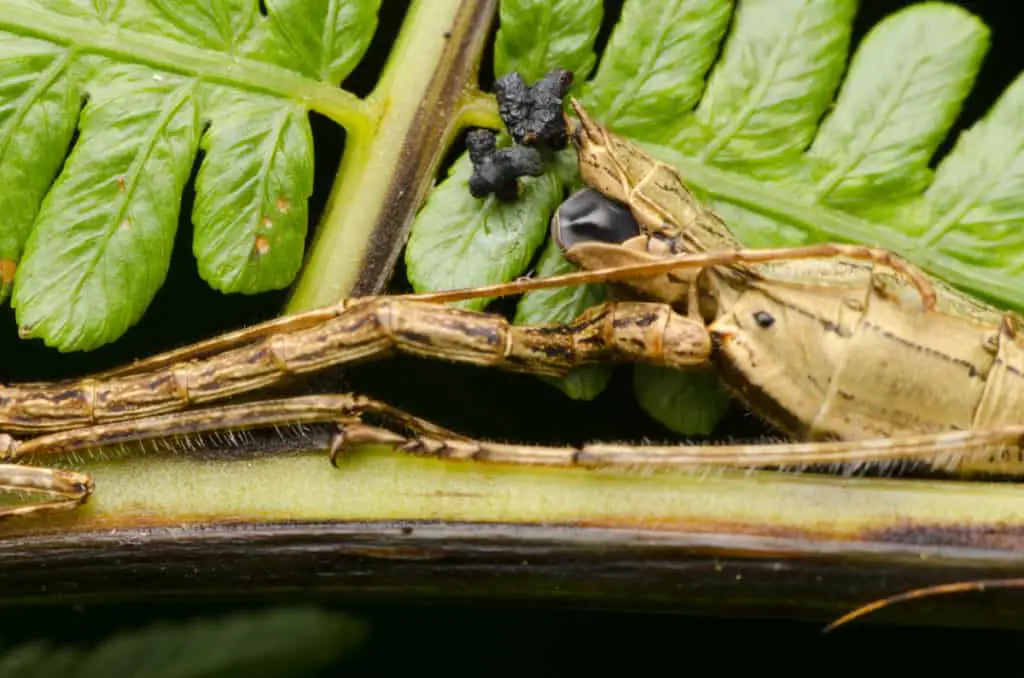
These eggs hatch into a nymph, there is no larval stage, and the nymphs shed their skin five to nine times before reaching adulthood. The stick insects often eat their molted skin after molting.
The final molts usher the insect close to the sub-adult and then to the adult stage. A stick insect’s typical lifespan is between one to three years in the wild.
Praying Mantis
The praying mantis also doesn’t have a larval stage meaning it goes from egg to nymph and then adult. Their eggs hatch within 3 weeks for smaller species and 6 weeks for larger species. The ootheca usually has a compartment for each egg. These compartments feature valve-like structures that make it easy for the eggs to hatch with no outside help.
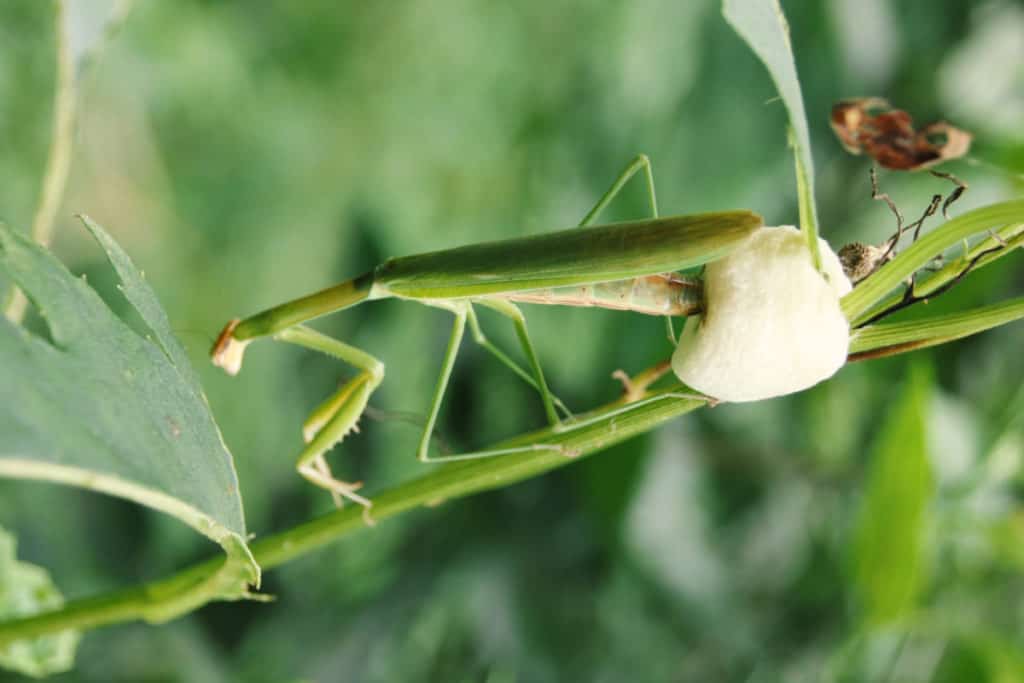
The nymphs emerge from the ootheca in spring and are ready to begin feeding. They feed as they molt until they reach adulthood. Praying mantis will molt six times only before they reach adulthood and after this, they will emerge with wings. The nymphs grow the entire summer to reach adulthood.
Here lies another similarity. Both the praying mantis and the stick bug are hemimetabolous. These are insects that move from egg to nymph to adult omitting the pupal stage. That’s also known as incomplete metamorphosis.
What Do They Eat?
Stick Bug
Stick bugs are herbivorous insects that like to feed on leaves, specifically broadleaf varieties. In North America, the bramble leaves are a firm favorite because the plant is evergreen and plentiful all year round.
But generally, the stick bug loves moist leaves like those found on privet trees which are another favorite source of food. They also love the leaves of gum trees like eucalyptus. The good news is that stick insects love to eat quite a number of leaves from different trees so they are not confined to just a few mentioned here.
Praying Mantis
The praying mantis eats insects and other organisms. It can only survive on a live diet. These insects are ambush predators meaning they hide and jump on their unsuspecting prey, grasping them with their strong front legs and paralyzing them with a bite on the neck.
Interestingly, this insect that is only inches in size at most can prey on snakes and birds. They have very strong digestive juices that are instrumental in breaking down large prey. They lack venom so once they catch their prey; they immobilize it and begin to eat it from the head for the least resistance. Although they are insects, the praying mantis is considered one of the most ferocious predators.
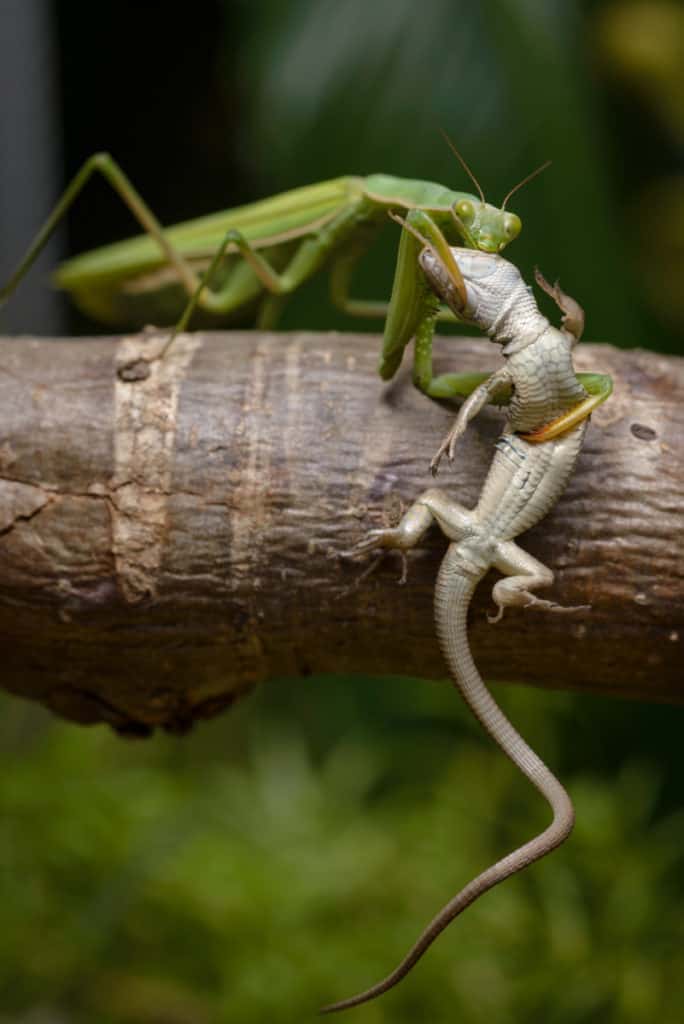
It is important to note that when a mantis goes for larger prey, they are usually the larger mantis species that has a weight advantage over their prey.
If you are interested we have a whole article on the diets and hunting abilities of praying mantis. The article is called, What Do Praying Mantis Eat? (With Video Hunting A Fish)
Can They Harmful To Humans Or Pets?
Stick Bugs
They are harmless to human beings or pets. In fact, they are more likely to play dead when you come across them to escape attention. However, when they are cornered, they can emit a strong-smelling substance to deter potential threats from approaching.
Some of the larger species that have spines on their legs can scratch as they attempt to get away when you reach for them.
Praying Mantis
The praying mantis is not venomous and unlike the stick insects, they do not squirt or spit any offending substance to keep away predators.
Praying mantis does have a bite that can tear the head and limbs of their prey from their bodies, but their bite is not dangerous to people or pets. Unless of course, you have pet insects…
They do however put on a good defensive show rising up on their hind legs and opening their wings to increase their girth and scare away predators. They also produce a hissing sound as part of their defense mechanism.
Can You Keep Praying Mantis And Stick Bugs As Pets?
Yes, stick bugs can be kept as pets and the praying mantis too. You need to create a cage for each and place food into the cage to ensure that the insects are well fed.
However, the stick insect requires less maintenance compared to the praying mantis. You can leave the stick bug for a week without constantly checking in and it will be fine as long as it has food. But the praying mantis requires daily care to maintain humidity levels and also to feed them live food.
In addition, when the mantis is molting, you need to remove the live food so that they are not stressed.
Taxonomy
Both insects belong to the kingdom Animalia, phylum Arthropoda, and class Insecta.
Stick Bug
The stick insects belong to the cohort: Polyneoptera
- Magorder: Polyorthoptera
- Superorder: orthopterida
- Order: Phasmatodea
These stick bugs belong to three suborders: Timematodea, Agathemerodea, or Verophasmatodea.
These insects come in 3,000 species and belong to either one of these orders.
Praying Mantis
The praying mantis is from the superorder Dictyoptera
- Subfamily: Mantodea
- Family: Mantidae
There are over 430 genera of praying mantis and over 1,800 species of insect.
| Praying Mantis | Stick Bug |
| Needs a male and female to reproduce | Can reproduce by parthenogenesis |
| Can’t regrow limbs | Can regrow limbs |
| Feeds on insects and large prey | It is a herbivore |
| Doesn’t spit in defense | Spits in defense |
The Wrap Up
There are several similarities between praying mantis and stick bugs which would explain the significant confusion they pose to many people.
For example, they both have a head, thorax, and abdomen. These insects also come in the same colors of brown, green, and black even though some praying mantis may appear to have a pink tinge to them. Also, both insects need tropical to subtropical temperatures. They generally like temperatures between 60-77 degrees Fahrenheit.
Although there are quite some similarities between these two insects, their differences are significant. One is a herbivore while another is a ruthless predator. If the diet alone doesn’t differentiate them, a look at their breeding characteristic, their family, and genera are enough to dispel any confusion.
One thing they have in common is their ability to become excellent pets.
If you like this kind of comparison type article you might be interested in checking out some other articles where we compare different bugs. The links to these articles are below:
Clover Mites Vs Chiggers – Are They The Same Thing?
Clover Mites Vs Spider Mites: What is the Difference?
Carpenter Bees Vs Bumblebees Vs Honey Bees
Sources
https://science.sciencemag.org/content/359/6377/765/tab-figures-data
https://en.wikipedia.org/wiki/Phobaeticus_kirbyi
https://www.inaturalist.org/guide_taxa/348934
https://www.nationalgeographic.com/animals/invertebrates/p/praying-mantis/
https://www.earthlife.net/insects/lifecycles.html
https://kids.nationalgeographic.com/animals/invertebrates/insects/praying-mantis/
https://insektenliebe.com/everything-you-need-to-know-about-an-ootheca/?lang=en
